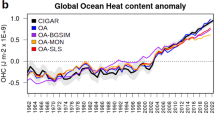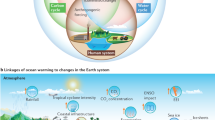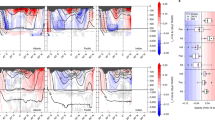Abstract
The Southern Ocean has, on average, warmed and freshened over the past several decades. As a primary global sink for anthropogenic heat and carbon, to understand changes in the Southern Ocean is directly relevant to predicting the future evolution of the global climate system. However, the drivers of these changes are poorly understood, owing to sparse observational sampling, large amplitude internal variability, modelling uncertainties and the competing influence of multiple forcing agents. Here we construct an observational synthesis to quantify the temperature and salinity changes over the Southern Ocean and combine this with an ensemble of co-sampled climate model simulations. Using a detection and attribution analysis, we show that the observed changes are inconsistent with the internal variability or the response to natural forcing alone. Rather, the observed changes are primarily attributable to human-induced greenhouse gas increases, with a secondary role for stratospheric ozone depletion. Physically, the simulated changes are primarily driven by surface fluxes of heat and freshwater. The consistency between the observed changes and our simulations provides increased confidence in the ability of climate models to simulate large-scale thermohaline change in the Southern Ocean.
This is a preview of subscription content, access via your institution
Access options
Access Nature and 54 other Nature Portfolio journals
Get Nature+, our best-value online-access subscription
$29.99 / 30 days
cancel any time
Subscribe to this journal
Receive 12 print issues and online access
$259.00 per year
only $21.58 per issue
Buy this article
- Purchase on Springer Link
- Instant access to full article PDF
Prices may be subject to local taxes which are calculated during checkout





Similar content being viewed by others
Data availability
All the data used in this article are publicly available. The CanESM2 large ensembles are available at http://open.canada.ca/data/en/dataset/aa7b6823-fd1e-49ff-a6fb-68076a4a477c. The RG Argo climatology is available at http://sio-argo.ucsd.edu/RG_Climatology.html. The historical profiles from the World Ocean Database can be found at https://www.nodc.noaa.gov/OC5/WOD/pr_wod.html.
References
Armour, K., Marshall, J., Scott, J., Donohoe, A. & Newsom, E. Southern Ocean warming delayed by circumpolar upwelling and equatorward transport. Nat. Geosci. 9, 549–554 (2016).
Fan, T., Deser, C. & Schneider, D. P. Recent Antarctic sea ice trends in the context of Southern Ocean surface climate variations since 1950. Geophys. Res. Lett. 41, 2419–2426 (2014).
Parkinson, C. L. & Cavalieri, D. J. Antarctic sea ice variability and trends, 1979–2010. Cryosphere 6, 871–880 (2012).
Gille, S. T. Warming of the Southern Ocean since the 1950s. Science 295, 1275–1277 (2002).
Gille, S. T. Decadal-scale temperature trends in the Southern Hemisphere ocean. J. Clim. 21, 4749–4765 (2008).
Durack, P. J. & Wijffels, S. E. Fifty-year trends in global ocean salinities and their relationship to broad-scale warming. J. Clim. 23, 4342–4362 (2010).
Roemmich, D. et al. Unabated planetary warming and its ocean structure since 2006. Nat. Clim. Change 5, 240–245 (2015).
Khatiwala, S., Primeau, F. & Hall, T. Reconstruction of the history of anthropogenic CO2 concentrations in the ocean. Nature 462, 346–349 (2009).
Frölicher, T. L. et al. Dominance of the Southern Ocean in anthropogenic carbon and heat uptake in CMIP5 models. J. Clim. 28, 862–886 (2015).
Böning, C., Dispert, A., Visbeck, M., Rintoul, S. & Schwarzkopf, F. The response of the Antarctic Circumpolar Current to recent climate change. Nat. Geosci. 1, 864–869 (2008).
Gent, P. R. & Danabasoglu, G. Response to Increasing Southern Hemisphere Winds in CCSM4. J. Climate 24, 4992–4998 (2011).
Swart, N. C. & Fyfe, J. C. The influence of recent Antarctic ice sheet retreat on simulated sea ice area trends. Geophys. Res. Lett. 40, 4328–4332 (2013).
Polvani, L. M. & Smith, K. L. Can natural variability explain observed Antarctic sea ice trends? New modeling evidence from CMIP5. Geophys. Res. Lett. 40, 3195–3199 (2013).
Gagné, M.-È., Gillett, N. P. & Fyfe, J. C. Observed and simulated changes in Antarctic sea ice extent over the past 50 years. Geophys. Res. Lett. 42, 90–95 (2015).
Zunz, V., Goosse, H. & Massonnet, F. How does internal variability influence the ability of CMIP5 models to reproduce the recent trend in Southern Ocean sea ice extent? Cryosphere 7, 451–468 (2013).
Lovenduski, N. S., Fay, A. R. & McKinley, G. A. Observing multidecadal trends in Southern Ocean CO2 uptake: what can we learn from an ocean model? Global. Biogeochem. Cycles 29, 416–426 (2015).
Fyfe, J. Southern Ocean warming due to human influence. Geophys. Res. Lett. 33, L19701 (2015).
Sigmond, M., Reader, M. C., Fyfe, J. C. & Gillett, N. P. Drivers of past and future Southern Ocean change: stratospheric ozone versus greenhouse gas impacts. Geophys. Res. Lett. 38, L12601 (2011).
Solomon, A., Polvani, L. M., Smith, K. L. & Abernathey, R. P. The impact of ozone depleting substances on the circulation, temperature, and salinity of the Southern Ocean: an attribution study with CESM1(WACCM). Geophys. Res. Lett. 42, 5547–5555 (2015).
Barnett, T. P., Pierce, D. W. & Schnur, R. Detection of anthropogenic climate change in the world’s oceans. Science 292, 270–274 (2001).
Barnett, T. P. et al. Penetration of human-induced warming into the world’s oceans. Science 309, 284–287 (2005).
Pierce, D. et al. Anthropogenic warming of the oceans: observations and model results. J. Clim. 19, 1873–1900 (2006).
Pierce, D. W., Gleckler, P. J., Barnett, T. P., Santer, B. D. & Durack, P. J. The fingerprint of human-induced changes in the ocean’s salinity and temperature fields. Geophys. Res. Lett. 39, L21704 (2012).
Roemmich, D. & Gilson, J. The 2004–2008 mean and annual cycle of temperature, salinity, and steric height in the global ocean from the Argo Program. Prog. Oceanogr. 82, 81–100 (2009).
Bindoff, N. et al. in Climate Change 2013: The Physical Science Basis (eds Stocker, T. F. et al.) (Cambridge Univ. Press, Cambridge, 2013).
Gillett, N. P., Arora, V. K., Matthews, D. & Allen, M. R. Constraining the ratio of global warming to cumulative CO2 emissions using CMIP5 simulations. J. Clim. 26, 6844–6858 (2013).
Levitus, S. et al. Anthropogenic warming of Earth’s climate system. Science 292, 267–270 (2001).
Bitz, C. & Polvani, L. Antarctic climate response to stratospheric ozone depletion in a fine resolution ocean climate model. Geophys. Res. Lett. 39, L20705 (2012).
Sigmond, M. & Fyfe, J. C. Has the ozone hole contributed to increased Antarctic sea ice extent? Geophys. Res. Lett. 37, L18502 (2010).
Bindoff, N. L. & McDougall, T. J. Decadal changes along an Indian Ocean section at 32° S and their interpretation. J. Phys. Oceanogr. 30, 1207–1222 (2000).
Banks, H. T. & Bindoff, N. L. Comparison of observed temperature and salinity changes in the Indo-Pacific with results from the coupled climate model HadCM3: processes and mechanisms. J. Clim. 16, 156–166 (2003).
Aoki, S., Bindoff, N. & Church, J. Interdecadal water mass changes in the Southern Ocean between 30° E and 160° E. Geophys. Res. Lett. 32, L07607 (2005).
Gille, S. T. Meridional displacement of the Antarctic Circumpolar Current. Phil. Trans. R. Soc. 372, 20130273 (2014).
Freeman, N. M., Lovenduski, N. S. & Gent, P. R. Temporal variability in the Antarctic Polar Front (2002–2014). J. Geophys. Res. Oceans 121, 7263–7276 (2016).
Pauling, A. G., Bitz, C. M., Smith, I. J. & Langhorne, P. J. The response of the Southern Ocean and Antarctic sea ice to freshwater from ice shelves in an Earth system model. J. Clim. 29, 1655–1672 (2016).
Fyfe, J. C., Gillett, N. P. & Marshall, G. J. Human influence on extratropical Southern Hemisphere summer precipitation. Geophys. Res. Lett. 39, L23711 (2012).
Abernathey, R. et al. Water-mass transformation by sea ice in the upper branch of the Southern Ocean overturning. Nat. Geosci. 9, 596–601 (2016).
Haumann, A., Gruber, N., Münnich, M., Frenger, I. & Kern, S. Sea-ice transport driving Southern Ocean salinity and its recent trends. Nature 537, 89–92 (2016).
Polvani, L. M., Previdi, M. & Deser, C. Large cancellation, due to ozone recovery, of future Southern Hemisphere atmospheric circulation trends. Geophys. Res. Lett. 38, L04707 (2011).
Previdi, M. & Polvani, L. M. Climate system response to stratospheric ozone depletion and recovery. Q. J. R. Meteorol. Soc. 140, 2401–2419 (2014).
Pritchard, H. D. et al. Antarctic ice-sheet loss driven by basal melting of ice shelves. Nature 484, 502–505 (2012).
Arora, V. K. et al. Carbon emission limits required to satisfy future representative concentration pathways of greenhouse gases. Geophys. Res. Lett. 38, L05805 (2011).
Yang, D. & Saenko, O. A. Ocean heat transport and its projected change in CanESM2. J. Clim. 25, 8148–8163 (2012).
Stone, D., Allen, M. R., Selten, F., Kliphuis, M. & Stott, P. A. The detection and attribution of climate change using an ensemble of opportunity. J. Clim. 20, 504–516 (2007).
Acknowledgements
We acknowledge the Environment and Climate Change Canada’s Canadian Centre for Climate Modelling and Analysis for executing and making available the CanESM2 Large Ensemble simulations used in this study, and the Canadian Sea Ice and Snow Evolution Network for proposing the simulations. S.T.G. acknowledges NSF awards PLR-1425989 and OCE 1658001.
Author information
Authors and Affiliations
Contributions
N.C.S. conducted the analysis the wrote the paper. S.T.G. obtained and preprocessed the observational data. J.C.F. proposed the paper. N.P.G. advised on the detection and attribution. All the authors contributed to the scientific interpretation of the results, and helped to edit the paper.
Corresponding author
Ethics declarations
Competing interests
The authors declare no competing interests.
Additional information
Publisher’s note: Springer Nature remains neutral with regard to jurisdictional claims in published maps and institutional affiliations.
Supplementary information
Supplementary Information
Supplementary Text and Supplementary Figures 1–8.
Rights and permissions
About this article
Cite this article
Swart, N.C., Gille, S.T., Fyfe, J.C. et al. Recent Southern Ocean warming and freshening driven by greenhouse gas emissions and ozone depletion. Nature Geosci 11, 836–841 (2018). https://doi.org/10.1038/s41561-018-0226-1
Received:
Accepted:
Published:
Issue Date:
DOI: https://doi.org/10.1038/s41561-018-0226-1
This article is cited by
-
Microbial metabolomic responses to changes in temperature and salinity along the western Antarctic Peninsula
The ISME Journal (2023)
-
Antarctic shelf ocean warming and sea ice melt affected by projected El Niño changes
Nature Climate Change (2023)
-
Isotopic evidence for an intensified hydrological cycle in the Indian sector of the Southern Ocean
Nature Communications (2023)
-
Ocean heat uptake and interbasin redistribution driven by anthropogenic aerosols and greenhouse gases
Nature Geoscience (2023)
-
Relative contributions of internal variability and external forcing to the inter-decadal transition of climate patterns in East Asia
npj Climate and Atmospheric Science (2023)



